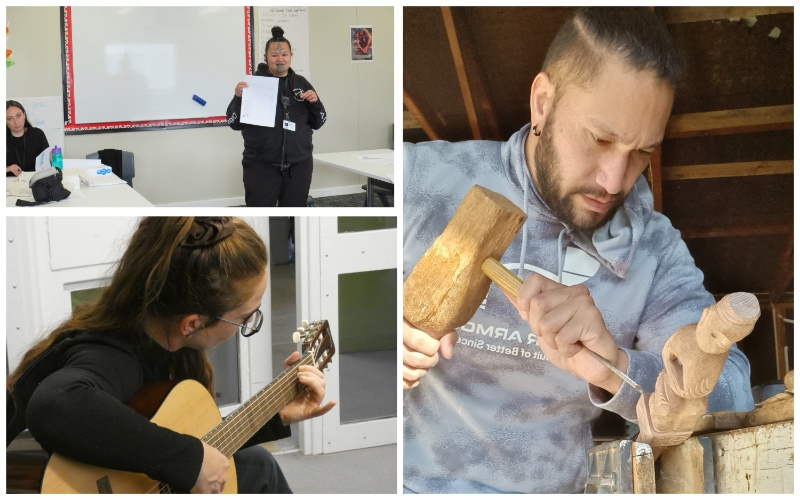 What does it take to deliver successful arts programmes in prisons? And what difference are the 13 arts programmes in the Creative Arts and Cultural Wellbeing Prison Initiative making?
What does it take to deliver successful arts programmes in prisons? And what difference are the 13 arts programmes in the Creative Arts and Cultural Wellbeing Prison Initiative making?
These are the two key questions driving the evaluation of the Creative Arts and Cultural Wellbeing Prison Initiative, a partnership between Manatū Taonga and Ara Poutama Aotearoa. Manatū Taonga has invested $3 million into 13 arts programmes being delivered over three years.
 The programmes range from whakairo and raranga to music therapy, creative writing, theatre and visual art. They are being delivered in 14 prison sites from Invercargill and Otago through to Tongariro, Auckland and Northland.
The programmes range from whakairo and raranga to music therapy, creative writing, theatre and visual art. They are being delivered in 14 prison sites from Invercargill and Otago through to Tongariro, Auckland and Northland.
Tony O’Connor, Co-director, Point and Associates, is leading the evaluation with Hector Kaiwai (Ngāti Porou, Ngāti Maniapoto, Tūhoe) of Awa Associates.
Tony describes the evaluation project as “totally exciting” and says it’s the first time in New Zealand that programmes across a range of artforms and prison sites have been evaluated over a three-year period.
Evidence, insights and increased knowledge
The process got under way at the beginning of 2023 and will be completed in July 2025.
“Some of the arts practitioners have a deep knowledge of working in prisons while others are new to it,” Tony says. “Our hope is that the evaluation will offer evidence, insights and increased knowledge about effective arts programmes to artists, Corrections staff and the public.
“We’ve spent time with each provider to get to know each other, discuss the purpose of the evaluation, learn about their programmes, and develop an evaluation approach that suits them and meets the evaluation objectives.
“We’re also talking to prisoners and prison staff about how the programmes are working and the difference they’re making.
“People with decades of experience in prisons – administrators, directors, officers – have told me our prisons need consistent, effective arts programming to achieve the goals of the Hokai Rangi Strategy.”
Hokai Rangi Strategy goals
The Hōkai Rangi Strategy 2019–2024 aims to address the over-representation of Māori in prisons. The concept of oranga or wellbeing is at the strategy’s heart.
 Earlier this year, Tony participated in a three-hour session of Whakahono ki nga wā ō mua, a programme focused on toi Māori being delivered by artist Sharne Parkinson in Invercargill Prison. “It was awesome. I got to make an ukutangi – a clay wind instrument – and talk to the men. They were keen to talk to me, tell me their stories and how they were benefiting from the programme.”
Earlier this year, Tony participated in a three-hour session of Whakahono ki nga wā ō mua, a programme focused on toi Māori being delivered by artist Sharne Parkinson in Invercargill Prison. “It was awesome. I got to make an ukutangi – a clay wind instrument – and talk to the men. They were keen to talk to me, tell me their stories and how they were benefiting from the programme.”
A third important question Tony and Hector are investigating is the impact that adequate funding makes to the programme delivery. “Security of funding over three years means the practitioners have more time to prepare and deliver an effective programme and ensure high-quality content.”
Arts Access Aotearoa is a member of the steering group, set up to monitor progress of the evaluation. Executive Director Richard Benge describes the initiative and evaluation process, undertaken by Corrections, as one of leadership in this under- resourced area.
The group meets quarterly and findings from the first year of the evaluation will be discussed with the group at its next meeting in late November.
 “This is an exciting opportunity to establish sustainable, high-quality arts programmes in prisons based on irrefutable evidence,” Richard says.
“This is an exciting opportunity to establish sustainable, high-quality arts programmes in prisons based on irrefutable evidence,” Richard says.
“The evaluation will inform Corrections’ work on a national framework for arts programmes across all prison sites in support of its Hōkai Rangi Strategy.”
Tony says the 12 arts providers (Te Mauri Ltd has two programmes) are delivering a range of arts programmes in different settings: high security, low security, remand, self-care units, men’s prisons, women’s prisons, shorter-term programmes and longer-term programmes.
Describing himself as a “geek” with a PhD in anthropology, Tony says: “We have a lot of variables to compare.”
International literature review
As well as collecting information about the programmes, he and Hector Kaiwai did an international literature review about “what works, in what contexts, for who, and how”.
“The review, which includes Arts Access Aotearoa’s own literature review, has informed our approach to the evaluation and initial thinking about what ‘good’ looks like.”
In measuring the success of a programme, what is “good”? Tony says it’s about the content of the programme; how it’s presented; the facilities available; staff support; remuneration; and the time available for programme delivery.
And at the end of the evaluation in July 2025? “By then, we will have solid evidence about what works, why it works and what is needed to deliver high-quality arts programmes across prisons in Aotearoa.”



